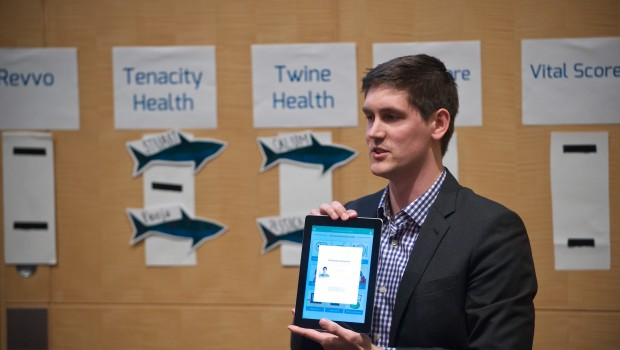Written by: Pothik Chatterjee, Brigham Innovation Hub, Brigham & Women’s Hospital
Testing digital health technology developed by start-ups in a relevant setting is crucial to determining the impact on patients and potential for adoption by clinicians. Testing can take place through pilots with medical centers or through specialized clinics geared towards testing innovative technology like the Next Generation Phenotyping Center set up by Calum MacRae, M.D., Chief of Cardiovascular Medicine, at Brigham & Women’s Hospital. The new Center co-develops technology with industry and identifies novel methodologies and applications needed for a more global and less biased approach to disease diagnosis, risk stratification, health monitoring and more.
“We need to bridge the gap between new datasets or new technologies and the traditional disease entities on which current medicine is based,” said MacRae. “Apps, digital medical devices, wearables and sensors hold great potential: but we need to map this onto disease in order to capture the added value necessary to improve patient care.”
MacRae and his colleagues at BWH are testing these devices in an active clinical setting in order to provide valuable feedback to start-ups as they refine their products in the development cycle. These efforts could also lead to better patient care and engagement by clinicians, increasing effectiveness and in the long run sustained growth of new ventures in digital health.
Dr. Calum Macrae
The digital health market enjoyed record-breaking levels of funding in 2014. According to Rock Health, venture funding for digital health companies surpassed $4.1B, nearly the total of all three prior years combined. For aspiring digital health entrepreneurs, it’s a veritable gold rush. Why now? And how long will this last?
Clearly, investor appetite for digital health startups is strong. Not only did total investment dollars increase 125% from 2013, volume of deals (close to 300) and average deal size ($14M) also rose. The gold rush in digital health is partly due to the Affordable Care Act (ACA). The ACA established financial incentives for healthcare providers and insurance companies to improve patient outcomes and quality of care. And the ubiquitous use of smartphones in consumer’s lives with on-demand apps and data analytics has filtered through to healthcare.
The gold rush into digital health raises the inevitable question – is there a bubble in the market? Not all these startups can succeed. The winners will require clear business models and must address questions such as who will pay for these innovations in digital health? Will it be the patient consumer, healthcare provider, insurance company, employer or a combination? How will they incentivize doctors and nurses to engage with apps, digital medical devices and telemedicine? How will busy and overextended clinicians interpret the deluge of data that will flow towards them from patients? Which startups will figure out these complex challenges and succeed? A survey from Rock Health’s newsletter predicted that FitBit, ZocDoc, Practice Fusion and Proteus Digital Health have potential.
If we compare digital health startups to public stocks, a rather different picture emerges. Five digital health companies went public in 2014 – Care.com, Castlight, Everyday Health, IMS and Imprivata. They all ended the year trading below their highs. Castlight, a company which creates software that lets employers manage employee healthcare costs, suffered a high-profile tumble. Castlight saw its shares soar to $40 after its March 2014 IPO. A year later, Castlight shares are trading at $8. Public investors seem apprehensive waiting for proven business models to emerge. Until then, many of the startups may not go public and sell to strategic acquirers instead.
An interesting counterpoint to Rock Health’s bullish outlook is a recent talk by Sachin Jain, MD, titled ‘The Perils of the HIT Gold Rush’ at the Health Leadership Forum organized by athenahealth. The new CMO of CareMore and former CMIO at Merck & Co, Jain cautions that a gap exists between problems that need to be solved and the solutions that are forthcoming.
According to Jain, “When you start thinking about opportunities there is so much low-hanging fruit, but entrepreneurs aren’t solving them because they are too busy making the next app so they can make $10 million.” At Brigham Innovation Hub, we similarly see a large number of startups in digital health that propose solutions that may not necessarily address urgent clinical problems faced by hospitals. One of the reasons is ‘founder bias’ – entrepreneurs tend to be relatively young, affluent and healthy – precisely the demographic that needs clinical intervention the least. Another reason is the lack of extended dialogue and collaboration between entrepreneurs and clinicians to understand and appreciate urgent clinical problems that can be solved by appropriate tools and technology.
We can go one step further and assert that clinical validation and testing is crucial for the long-term success of digital health innovation. We want to see more start-ups addressing the pain points and challenges of actual doctors and nurses in clinical settings. A few examples include monitoring patient adherence, integrating clinical support tools with EHR, using Apple HealthKit to empower patients to own their data and ResearchKit to accelerate clinical trial recruitment.
In order for digital health start-ups to flourish, they need to partner with hospitals to demonstrate evidence-based health outcomes. Working in large hospital settings can help start-ups prove their business model with providers, peers, and patients. Now is the time to connect the digital health experience from the smartphone screen to the clinician’s expertise and care.
Brigham Innovation Hub’s Shark Tank for startups to pilot at Brigham & Women’s Hospital in May 2014



Leave a Reply